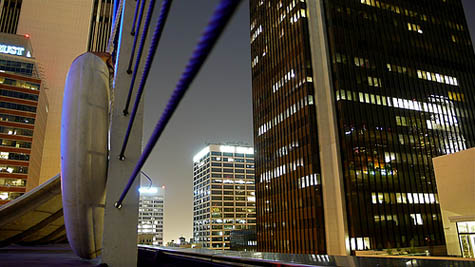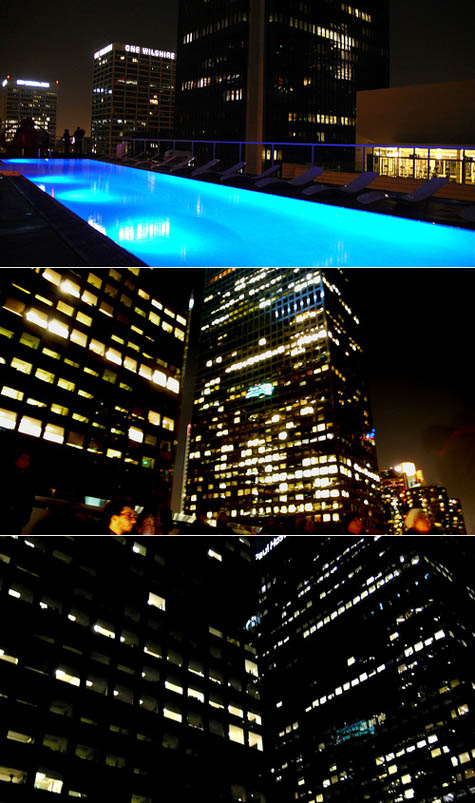Narrative Planetarium
Before his talk last week at Postopolis! LA, Matthew Coolidge, director of the Center for Land Use Interpretation, joked that someday he should bring a laser pointer up there to the roof deck and give a new lecture, pointing out specific offices visible around us in the nighttime sky.
That afterhours galaxy of Xerox machines and elevator shafts, paper-covered desks and meeting halls, would all be explained, room by room, from the artificially grassed crown of the Standard Hotel.
And though both of us laughed, I think it's an amazing idea.
 [Image: The view from Postopolis! LA; photo by Dan Hill].
[Image: The view from Postopolis! LA; photo by Dan Hill].
Standing up there in the darkness, looking at bank towers and real estate investment firms, individual offices lit from within (and even whole hallways, stretching horizontally into the sky before disappearing into themselves through a trick of perspective), the 16th, 17th, and much-higher stories of the city all visible to us like an architectural section, you could narrate a kind of local micro-history of nighttime spaces in LA.
It wouldn't be giving a lecture so much as becoming a planetarium.
"In that building over there," Coolidge might say, pointing his laser at a window four blocks distant, "the man who invented Technicolor once worked; and in that office over there" – pointing yet further, to One Wilshire, visible from the pool side of the building – "the internet traffic through which you're able to write this post passes everyday."
And so on.
The woman who first dreamt up and mapped the flight paths of intercontinental passenger airplanes over LAX once ran a property law services firm in that office, just barely visible with a laser pointer down there.
 [Images: The artificial astronomy of downtown Los Angeles, as seen during Postopolis! LA; photographed by Dan Hill].
[Images: The artificial astronomy of downtown Los Angeles, as seen during Postopolis! LA; photographed by Dan Hill].
Or perhaps it could be a new form of immersive storytelling: local novelists stop by every third Friday of the summer months and, in the darkness, using laser pointers, they invent family dramas, murder mysteries, political thrillers, and end-of-the-world catastrophes, all the while pointing to specific rooms and halls within which the action takes place – even the specific computer monitor, visible in someone's unblinded window, where plot-defining government secrets are thought to be stored...
Alternative fictions of the city.
In a way, I'm reminded of the brilliant Access Restricted program, curated by the Lower Manhattan Cultural Council (the final edition of which is April 28). Access Restricted is a "free nomadic lecture series that opens rarely visited and often prohibited spaces in Lower Manhattan to the general public" – meaning that certain offices, lobbies, meeting rooms, and even whole buildings directly relevant to the lecture taking place inside them are temporarily opened up for public visitation.
But imagine a rooftop version to this, a kind of Rooftops Restricted: you take a roof somewhere in midtown Manhattan and you give it to Paul Auster for the night, with a microphone in one hand and a laser pointer in the other, with 10 or 15 people camped out in sweaters all around him.
Next week, it's Jonathan Lethem; the week after that, Joseph O'Neill.
You generate a new ad hoc literature for the city, a narrative planetarium that radiates stories outward from the rooftops into the city.
That afterhours galaxy of Xerox machines and elevator shafts, paper-covered desks and meeting halls, would all be explained, room by room, from the artificially grassed crown of the Standard Hotel.
And though both of us laughed, I think it's an amazing idea.
 [Image: The view from Postopolis! LA; photo by Dan Hill].
[Image: The view from Postopolis! LA; photo by Dan Hill].Standing up there in the darkness, looking at bank towers and real estate investment firms, individual offices lit from within (and even whole hallways, stretching horizontally into the sky before disappearing into themselves through a trick of perspective), the 16th, 17th, and much-higher stories of the city all visible to us like an architectural section, you could narrate a kind of local micro-history of nighttime spaces in LA.
It wouldn't be giving a lecture so much as becoming a planetarium.
"In that building over there," Coolidge might say, pointing his laser at a window four blocks distant, "the man who invented Technicolor once worked; and in that office over there" – pointing yet further, to One Wilshire, visible from the pool side of the building – "the internet traffic through which you're able to write this post passes everyday."
And so on.
The woman who first dreamt up and mapped the flight paths of intercontinental passenger airplanes over LAX once ran a property law services firm in that office, just barely visible with a laser pointer down there.
 [Images: The artificial astronomy of downtown Los Angeles, as seen during Postopolis! LA; photographed by Dan Hill].
[Images: The artificial astronomy of downtown Los Angeles, as seen during Postopolis! LA; photographed by Dan Hill].Or perhaps it could be a new form of immersive storytelling: local novelists stop by every third Friday of the summer months and, in the darkness, using laser pointers, they invent family dramas, murder mysteries, political thrillers, and end-of-the-world catastrophes, all the while pointing to specific rooms and halls within which the action takes place – even the specific computer monitor, visible in someone's unblinded window, where plot-defining government secrets are thought to be stored...
Alternative fictions of the city.
In a way, I'm reminded of the brilliant Access Restricted program, curated by the Lower Manhattan Cultural Council (the final edition of which is April 28). Access Restricted is a "free nomadic lecture series that opens rarely visited and often prohibited spaces in Lower Manhattan to the general public" – meaning that certain offices, lobbies, meeting rooms, and even whole buildings directly relevant to the lecture taking place inside them are temporarily opened up for public visitation.
But imagine a rooftop version to this, a kind of Rooftops Restricted: you take a roof somewhere in midtown Manhattan and you give it to Paul Auster for the night, with a microphone in one hand and a laser pointer in the other, with 10 or 15 people camped out in sweaters all around him.
Next week, it's Jonathan Lethem; the week after that, Joseph O'Neill.
You generate a new ad hoc literature for the city, a narrative planetarium that radiates stories outward from the rooftops into the city.





Comments are moderated.
If it's not spam, it will appear here shortly!
The idea of the building as an open ground is very intriguing, these spaces in the city are usually closed containers in the day, and at night they become windows to look into...
This suggests another intriguing use of the residual space at the tops of buildings. Ever since I visited a beer garden at the top of a downtown office building in Toronto over a decade ago, I never understood the resistance to occupying this space in NYC.
Post a Comment